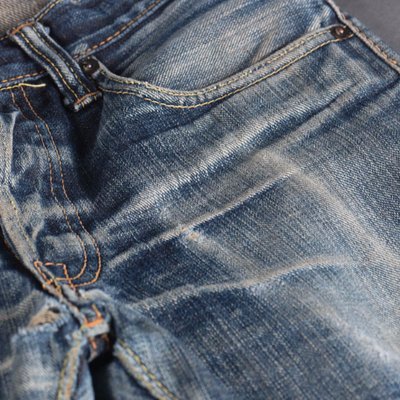

Jeans on display showing off fade and wear

I can mention though that there is denim out there at 25 ounces, so there’s always a kid with a daddy bigger than yours. Regular high-street denim is more likely to be single-figure weight, and your usual premium raw denim likely to be 12 or 14 ounces. At this thickness you’re already running into problems making trousers from it, and it makes the process of hemming it difficult as well. The heavier it is, the stiffer and thicker it is, and 21 ounces is about as thick as it is practical to weave it. Shrinkage around waist and thighs will widen out again with use, but the length of the legs will only shrink, and up to an inch in many cases.Īnd then there is the 21 ounces. Another point of having the trousers intentionally on the long side is to allow for shrinkage. Where the edge is self-finished to avoid the unravelling of the fabric, this self-edge is often in contrasting stripes, and hence why you wear the trousers with a turn-up, to show it off. The selvedge, or more correctly self-edge, relates to how the edge of the fabric is finished. No pre-distressing here either, part of the game is that the wearers must wear the jeans and create their own wear patterns and fades in the colour, and hence make them unique and their own.

Some of the denim will have been washed once, in cold water, to stabilise shrinking. There will be special, fiddly dyeing processes as well, and this is where the “raw” comes into it, as the denim has been dyed and then left untreated, which means a lot to how the colour will fade, as the jeans are worn.Īnd these fades are very much what it’s all about. The best (as in expensive and special) types of denim are made in small runs on vintage looms, to the exact specification of the often small artisan workshop sewing jeans from it. Why? The Japanese appear to be the most obsessive in their devotion to creating and recreating things, be it denim or vintage workwear. Now admittedly that last sentence may not make much sense to most people, but let’s break it down a bit and see what it means.ĭenim from Japan is considered by most enthusiasts to be the most desirable. Quite by chance really, as I wasn’t aware that I very much needed a new pair of special jeans until a friend pointed out to me that my life could be regarded as incomplete and unfulfilled without a pair of Japanese Iron Heart raw selvedge jeans in super-heavy-weight 21 oz denim.

I recently had the opportunity to visit the new showroom of Rivet & Hide, a mainly internet retailer of rare and spectacular denim and other fine related articles. Which was a good vantage point into the odd ball world of high end denim. In recent years I’ve been wearing either Carhartt or Nudie jeans of various types, though last year I took the plunge and upgraded to a pair of more expensive Welsh jeans. And while I wouldn’t characterize myself as a denim nerd (we’ll hear more about these guys in a bit) I will profess a genuine interest in the topic and I do enjoy a really good pair of jeans. From the stonewashed jeans of the 80’s to the increasingly boringly styled and baggier jeans of middle-age, I’ve never been without a pair or two, even though other types of trousers have come and gone. Shop visit: Rivet & Hide, rare denim for puristsīeing of the age I am, denim has always been a part of my life, in some form or another.


 0 kommentar(er)
0 kommentar(er)
